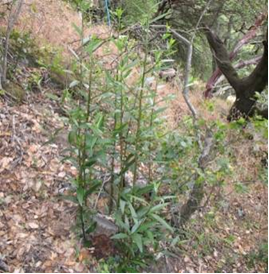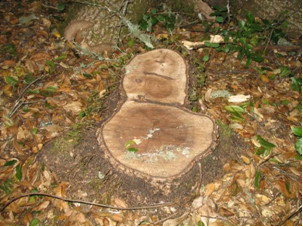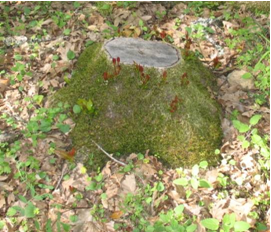
Trees that are too difficult to cut can be killed using herbicides, although this method may not be suitable in many situations. Herbicide-treated California bays may not die for an extended period of time (months to over a year) and may continue to produce P. ramorum spores during this time. Also, because trees are left to die in place, management concerns related to visual appearance, fire hazard, and tree failure hazards can limit where herbicide treatments can be used. If herbicide-treated trees will eventually need to be cut due to hazard issues, direct removal is preferable.
The most common method for applying herbicides to kill large standing trees is the "hack and squirt" or frill method. A hatchet is used to make downward angled cuts through the bark around the circumference of the tree and herbicide (usually full-strength concentrate to quarter-strength dilution, depending on the product, follow the label directions) is immediately applied into the open wounds. Alternatively, a specialized hatchet- or lance-like herbicide injection device can be used to simultaneously cut the bark and apply herbicide.
Timing of herbicide application can make a large difference in efficacy. In a San Mateo County study, California bays treated with 20.5% glyphosate (hack and squirt method) in March died within a year, but trees in the same stand treated in July showed almost no effect of the application. Additional observations suggest that glyphosate applications made during the wet season from late fall through early spring are most effective in that area.
The efficacy of herbicides for killing large California bay trees may also vary geographically and by application method. For triclopyr and glyphosate, apply in overlapping cuts around the entire trunk circumference (Dave Boyd, California State Parks, pers. communication). Researchers in Humboldt County had poor results using injected imazapyr (Chris Lee, UC Cooperative Extension, pers. communication) whereas others (Dave Boyd, pers. communication) have found this material to be effective using a frill application with points spaced up to 15 cm (6 inches) apart around the trunk. Some herbicide combinations (e.g. imazapyr plus glyphosate) may be more effective than individual herbicides.
Stump sprouts from cut California bays may also be suppressed through the use of systemic herbicides such as glyphosate. Apply herbicides to the cambial area of freshly cut stumps. Appropriate herbicides may also be applied to sprouts after they develop on cut stumps, but such applications will typically require greater amounts of spray solution and pose a greater hazard to non-target plants from overspray and drift. In San Mateo County research plots, applications of glyphosate (diluted to 20.5% a.i.) to freshly cut stumps significantly and sometimes completely suppressed resprouting (fig. 3-4).
In one site, treatment of stumps with glyphosate in November resulted in death of California bays many meters from the nearest stump due to herbicide translocation through natural root grafts. At another site treated in September, well before the start of the rainy season, no effects of glyphosate translocation from treated stumps via root grafts was seen.



Figure 3-4—California bay stump sprouts one year after tree felling. Right-Strong sprout growth from a non-browsed, untreated bay stump. Middle-Suppressed growth from glyphosate treated stump. Left-Sprout growth of untreated stump kept in check by deer browsing.